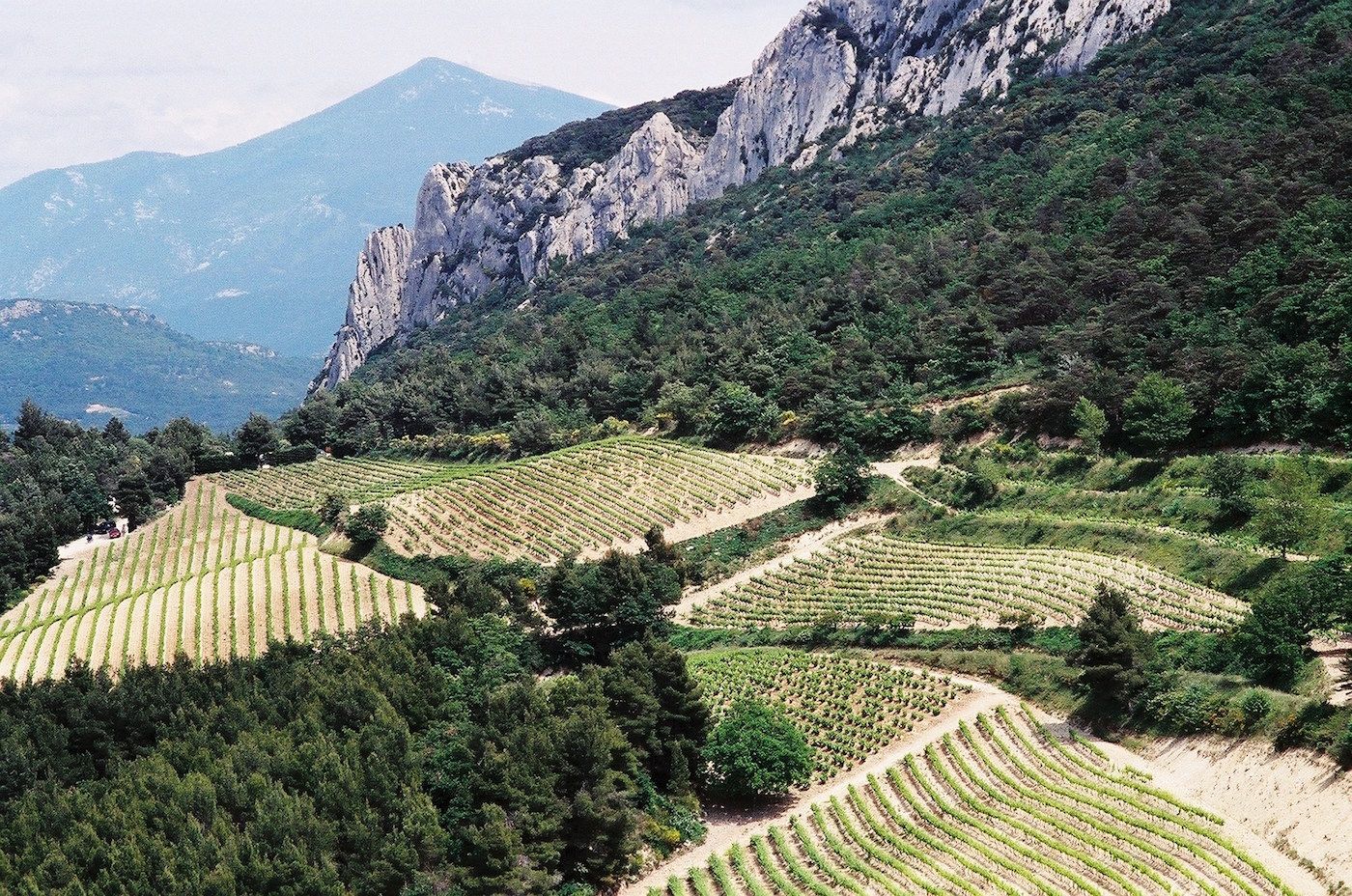Although at the moment white wines made from Clairette, Picpoul, Marsanne, Viognier and Bourboulenc can only be bottled as white Côtes du Rhône or IGP, the hope and expectation is that proposals to incorporate white Gigondas into the current AOC will materialise in the not too distant future.
The jagged peaks of the Dentelles de Montmirail range that jut out of the landscape and tower over the small village of Gigondas not only contribute to the particular microclimate that governs the higher altitude Gigondas vineyards, but are also a manifestation of the complex geological history of this part of the southern Rhône valley. Recent efforts to identify and nurture top vineyard sites have shown the sheer quality that can be achieved with old vines, skills and knowledge.

“I would feel very happy and confident picking up a bottle of Gigondas wherever the road takes me, and that surely is a sign of an AOC that is fulfilling its raison d’être.” Bart Feys
The picturesque town of Gigondas in the Vauclause Department in southeastern France is a little gem in the Southern Rhône valley crafting distinct, generous and age-worthy red wines. Wine making history can be traced back at least two millennia to a time when the Second Roman Legion based in Orange established vineyards in Gigondas. Remnants of Gallo-Roman vats can today still be seen if one visits the producer Chateau de Saint Cosme.
Nevertheless, vineyards have had their ups and downs in the landscape around Gigondas. After phylloxera ravaged vineyards in and beyond France at the end of the 19th century, lost vineyard sites in Gigondas were turned into olive groves for a steady and reliable income, only to be wiped out again following the devastating frosts of 1929 and in particular 1956. By then, Gigondas had started to make a name for itself, new ideas and expertise had been taken up and replanting of long lost vineyards returned with a vengeance, guided by identification of the most suitable sites. The days when Gigondas was sold in bulk for the fortification of poor Burgundy vintages was starting to look like a very distant memory.
Recognition of the unique character of Gigondas was cemented in 1971 when it was awarded its own AOC, allowed to produce red and rosé wines only. The red wine has to have a minimum of 50% Grenache, with Syrah and Mourvèdre playing the main supporting roles.
Total surface area of Gigondas today sits around 1,200 ha which is just over one third the size of Châteauneuf-du-Pape. Output is almost exclusively red wine with only 1% rosé produced. Nevertheless, growers such as Louis Barruol at Chateau Saint Cosme are at the forefront of identifying suitable sites in the Gigondas AOC for local white grape varieties (Clairette, Picpoul, Marsanne, Viognier, Bourboulenc etc) and have been actively establishing new vineyards on mostly limestone soils. Although at the moment these wines can only be bottled as white Côtes du Rhône or IGP, the hope and expectation is that proposals to incorporate white Gigondas into the current AOC will materialise in the not too distant future.
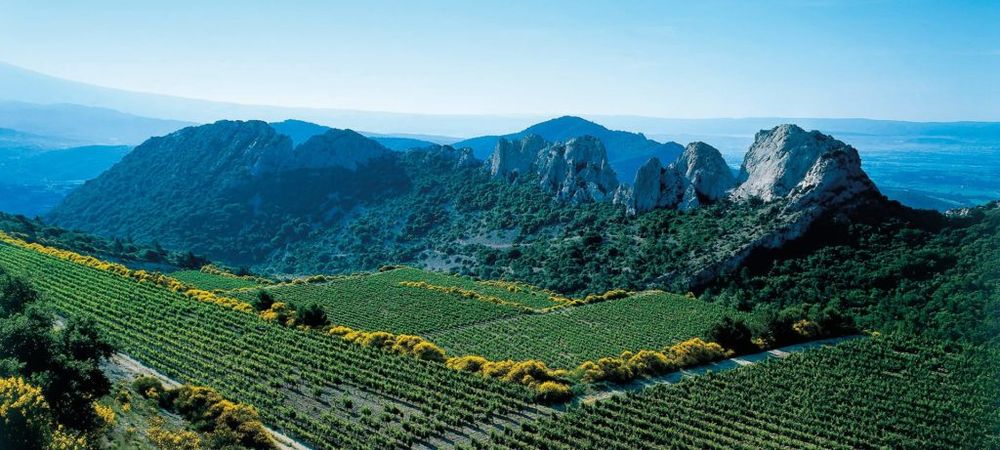
The dramatic backdrop to the vineyards in Gigondas is provided by the jagged edges of the Dentelles de Montmirail mountains, limestone ridges that have been pushed up from the sea millions of years ago. These have given rise to a varied patchwork of subsoils and terrains with some vineyards established at altitudes of over 500 metres.
The position of the Dentelles de Montmirail leads to shading of many vineyards early in the morning, and along with cooling breezes coming down from the ridges, in addition to the northerly Mistral wind, promotes the freshness and structure associated with Gigondas wine. This microclimate results in grapes ripening up to a few weeks later than in Châteauneuf-du-Pape, and despite having a similar cépage (majority Grenache), both Gigondas and Châteauneuf-du-Pape have on the whole distinct personalities, a reflection of their individual terroirs.

Gigondas, as indeed the Southern Rhône as a whole, has been blessed with some very good to great vintages recently. Both 2015 and 2016 have produced some beautiful examples, arguably the best since 2010. The problematic flowering of the Grenache vine in 2017 resulted in much reduced yields with the best producers crafting intense, tightly knit wines that will age very well.
Winemaking approaches are generally traditional using a mix of cement, large old foudres and barriques for fermentation and élévage, a percentage of which may be new. The practice of whole bunch fermentation – the retention of stems from the grapes before fermentation – varies wildly both between Domaines, but also from one cuvée to another, and from vintage to vintage. Well established proponents of destemming, such as Louis Barruol at Chateau Saint Cosme, argue that it imbues their wine with extra freshness, a finer tannic backbone and more elegance. Terroir will inevitably play an important role in the decision to include stems as a longer and steadier growing season will allow the stems to ripen gradually, and thereby avoid adding greenness to the must.
Other top Gigondas producers, such as the Domaine Raspail-Ay, which makes a single traditional cuvée, avoid destemming altogether without any obvious impact on quality. or perceived authenticity. Thank God there are no simple scientific dictats that govern all aspects of winemaking, and a few mysteries here and there keep us all jolly fascinated!
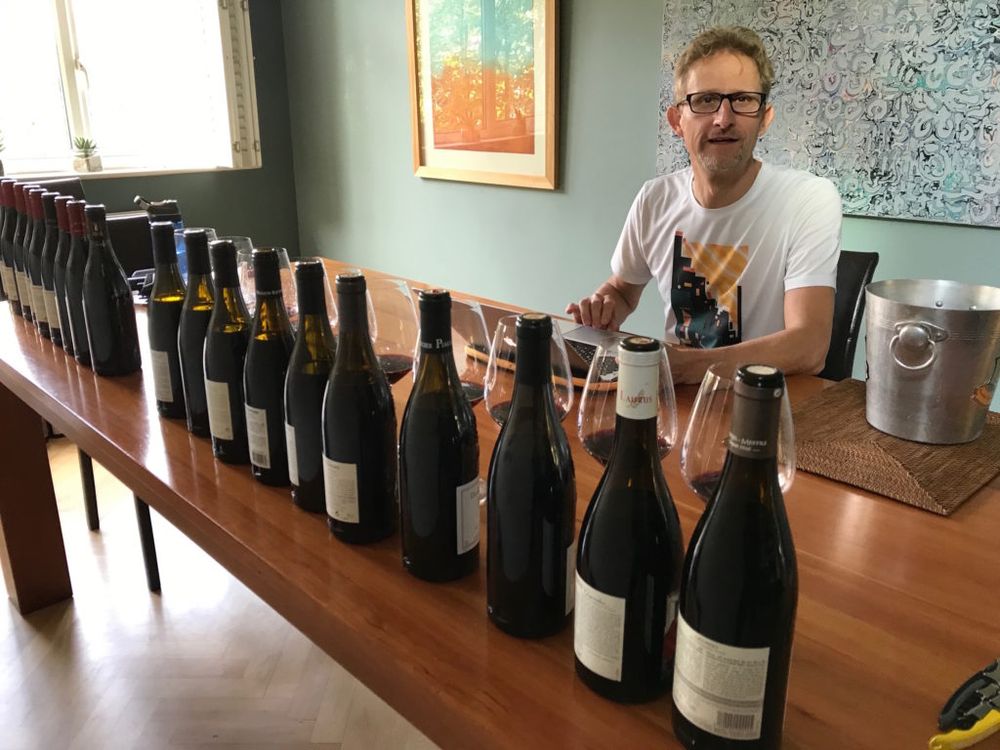
Bart Feys tasting through a range of Gigondas
Recently I tasted through a selection of 60-plus Gigondas wines, mostly from 2016 and 2017, with a few early examples of the 2018 vintage and the odd example from 2014 and 2015.
Strikingly, the overall quality was consistently high across the vintages, showing a smorgasbord of typical Southern Rhône characteristics such as garrigue, leather, bay, forest fruits, and darker roasted notes, admirable freshness, intensity and structure, but not at the expense of balance and food friendliness. I would feel very happy and confident picking up a bottle of Gigondas wherever the road takes me, and that surely is a sign of an AOC that is fulfilling its raison d’être.
Chateau Saint Cosme

This Domaine has been one of the standard bearers in Gigondas for more than 20 years and has been taken to new heights by the thoughtful and dynamic Louis Barruol. A recent focus has been on identifying suitable sites for white grape varieties and ultimately making the case for a white Gigondas AOC. Chateau Saint Cosme already produces a single vineyard white Côtes du Rhône from the Le Poste vineyard using old Clairette vines.
Louis Barruol has also spent a lot of time and energy establishing his cherished single vineyard cuvées Le Claux, Le Poste and Hominis Fides. The Valbelle cuvée, a blend of old vine parcels from across Gigondas, is no longer made and is now blended in with the straight Gigondas, made from 70% Grenache, 15% Syrah and 15% Mourvèdre. Louis Barruol has been using whole bunch fermentation for 25 years, believing it adds elegance and spiciness to his wines and imbuing them with ‘Gigondas soul’. He also does daily pump-overs and pigéage, an approach not widely practiced in Gigondas, although also routine at the highly regarded Domaine Raspail-Ay.
Louis Barruol is not one for sitting on his laurels, and recently purchased the Château de Rouanne estate in neighboring Vinsobres, for many years a source of grapes for his Côtes du Rhône, but now no doubt destined for a solo performance. The choice of Vinsobres is no surprise as its cooler high elevation vineyards produce sought-after fruit used by the likes of e.g. Jean Louis Chave for his Côtes du Rhône.
A stunning set of Gigondas wines here in 2017 with the Gigondas Le Poste my personal standout.
Domaine des Bosquets
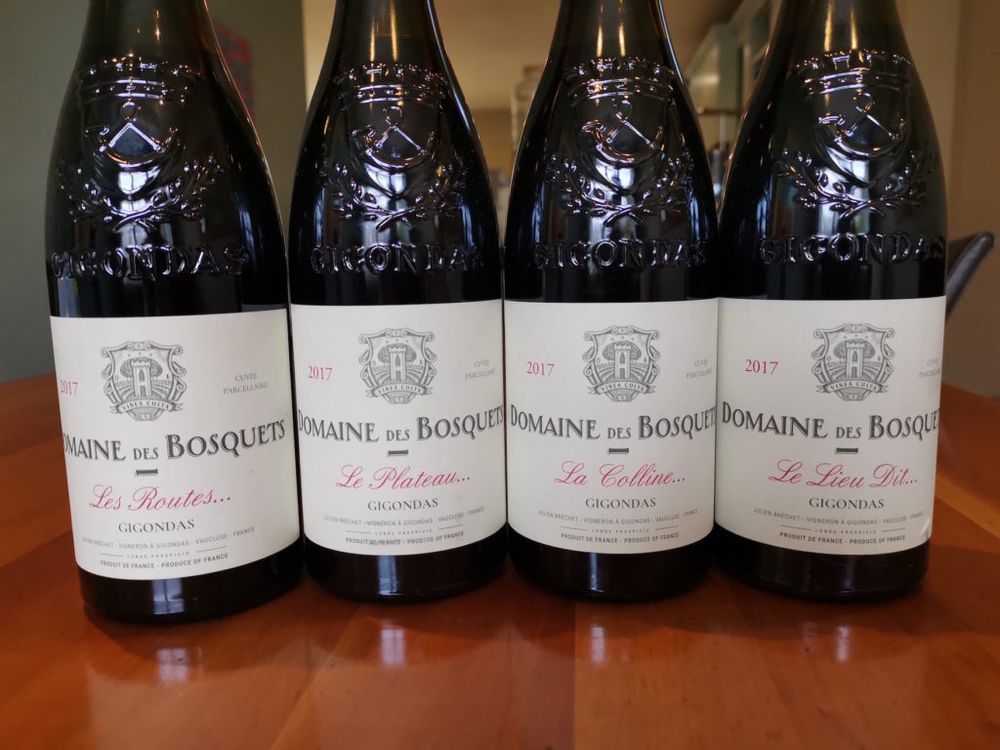
A large domaine (26 ha) with roots dating back to the 14th Century, this estate has been rejuvenated over the last decades, re-establishing and replanting old vineyards, some with plant material from the famed Chateau Rayas, introducing organic farming with the aim to operate biodynamically in the future. Increasing the general health of the vineyards has also allowed the stems of the grapes to ripen more fully, allowing for whole bunch fermentation where suitable.
A more recent focus has been to nurture known individual prime vineyard sites and bottle these separately to showcase site-specific character. A fascinating selection of unique sites has resulted in the following distinct cuvées. Le Lieu Dit and La Colline are both made from 100% Grenache. Le Lieu Dit was the first single vineyard wine produced at Domaine des Bosquets in 2009. This cooler northwest-facing vineyard is planted on sandy soils, is sheltered by surrounding woods and produces an elegant Gigondas marked by freshness.
The ‘La Colline’ vineyard on blue marl and limestone is more exposed and lies at an altitude of 350m producing a denser and more mineral cuvée. Les Routes is exclusively planted with the Petite Syrah (Serine) grape variety, sourced from the Fonsalette vineyard of Jacques Reynaud, which in turn was established with plant material from Jean Louis Chave. Tiny cuvée first produced in 2016. The final cuvée parcellaire in the lineup is ‘Le Plateau’ made from nearly 100% Mourvèdre, co-planted with small amounts of Syrah, Cinsault, Grenache and Clairette, producing a fresh and balanced wine with a dark savoury note.
A fascinating comparison of individual sites and cepage, with my favourite on the day being the 2017 Gigondas ‘Le Lieu Dit’.
A selection of the best 2016 Gigondas
Domaine La Bouissiere Gigondas La Font de Tonin: Traditional producer making classic ageworthy Gigondas; 81% Grenache, 19% Mourvèdre, no destemming. Deep purple, garrigue, gamey, leathery note, bursting with forest berries, fresh and structured, will develop longterm. I also highly recommended the 2017 Gigondas Tradition.
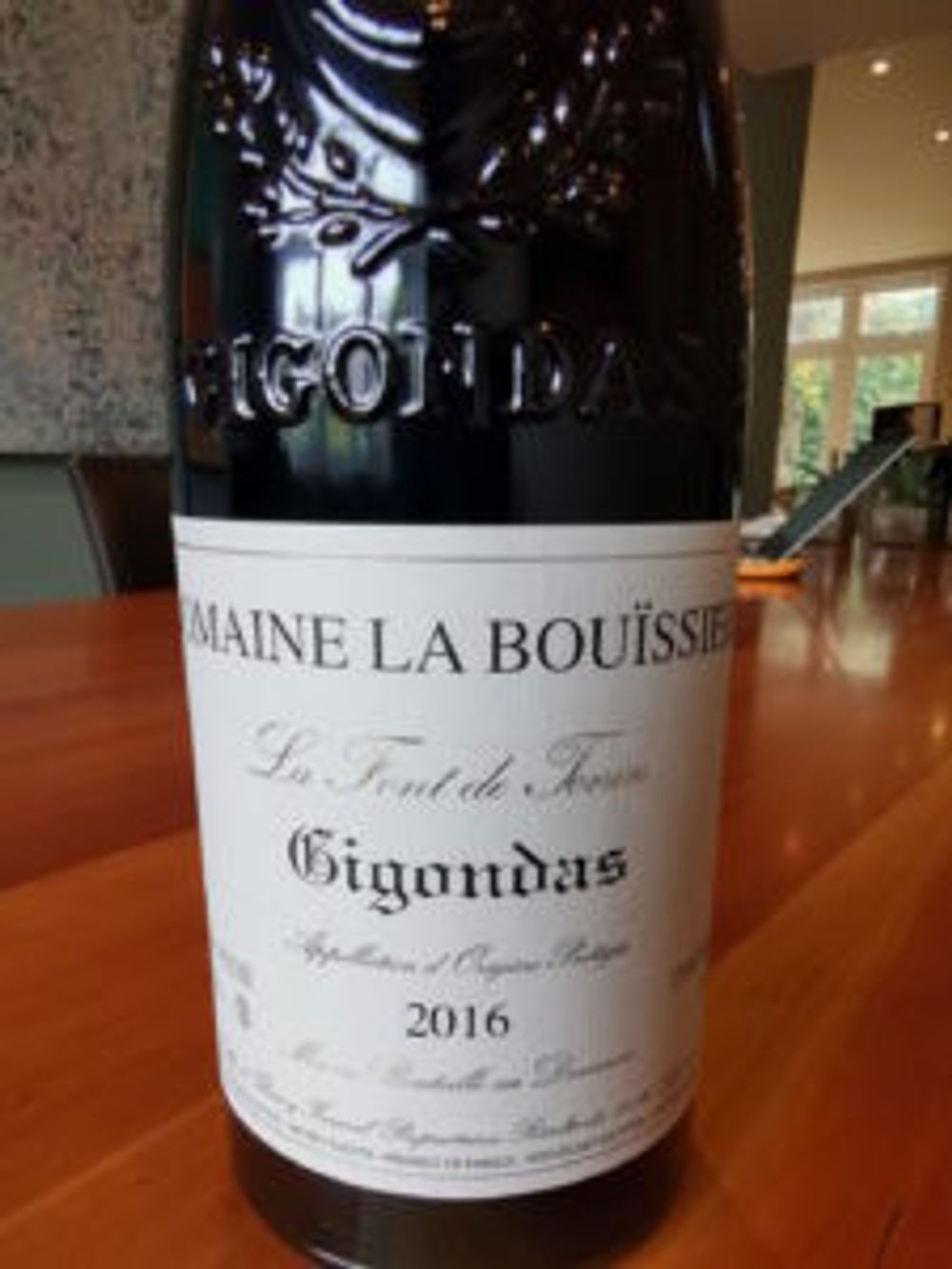
Domaine Raspail-Ay Gigondas: Classic, much lauded producer. 70% Grenache, 20% Syrah, 10% Mourvèdre, no destemming, long élévage. Mostly from Le Colombier lieu-dit. Powerful, kirsch and garrigue on nose, complex aromatics; stewed red fruits, lovely balance of complex brambly fruit and fresh gamey structure.
Domaine de Font Sane Gigondas Tradition: Grenache 72%, Syrah 23%, Mourvèdre 3%, Cinsault 2%. Light purple, cherries, herbs, garrigue, red fruited. Fresh and balanced, good value. Also tasted the excellent top cuvée 2017 Gigondas Terrasses des Dentelles.
Domaine de Piaugier Gigondas: Grenache 65%, Mourvèdre 20%, Syrah 15%. Generous, complex red fruit melange, classy nose with forest fruits and blackberries, kirschy red fruits with tannic structure. Crisp and young.
Pascal Frères Gigondas: Grenache 60%, Syrah 30%, Mourvèdre 10%. Made by négociant-vinificateur Yves-Cheron, who also makes the excellent Domaine du Grand Montmirail Gigondas. Garrigue and forest fruits on nose; gamey notes, fresh and lively with balanced tannins. Excellent for earlier drinking.
A selection of the best 2017 Gigondas
Moulin de la Gardette Gigondas Tradition: Grenache 80%, Mourvèdre 10%, Syrah 10%. Complex savoury nose, fresh garrigue/provencal herbs, fine and long with ripe tannic structure. Also impressive is the higher priced 2017 Gigondas Ventabren.

Domaine Brusset Gigondas Les Hauts de Montmirail: 55% Grenache, 20% Syrah, 20% Mourvèdre. Dark purple, blackberries, herbal note, intense and complex nose. Lovely, blue fruited palate with a lush, but crisp finish.
Pierre Amadieu Gigondas Romane Machotte: Grenache 80%, Syrah 20%. The most distinct wine in a range of Amadieu Gigondas cuvées. Roasted coffee, fresh and savoury.
Domaine de Fontavin Gigondas Combe Sauvage: Grenache, Syrah, Mourvèdre, Cinsault, Clairette. Deep purple, traditional garrigue-infused example, fresh and balanced.
Chateau Saint Cosme Gigondas Le Poste: 100% Grenache. The best site at Saint Cosme, according to Louis Barruol, and also home to Clairette vines vinified separately. Vines are now over 50 years old, whole bunch fermentation, raised in 20% new, 50% one-year old and 30% two-year old barriques. Deep purple, unevolved, stewed black fruits intermingled with herbal essence, darker graphite note than the Hominis Fides. Very crisp and firm structure that suggests cellaring is needed. Will be splendid.
Domaine des Bosquets Gigondas Le Lieu Dit: 100% Grenache on sandy soils, vineyard partly shaded by surrounding woods. Grapes 70% destemmed, raised in old 600 litre demi-muids. Light red purple, kirsch, red fruit coulis, cherries, very pure, intense and elegant, excellent freshness and length; compact and hedonistic, with lovely balance; ripe underlying structure.
Other recommended Gigondas
2014 Domaine Les Goubert Gigondas Cuvée Florence: Grenache, Syrah; raised in 50% new oak. Deep mahogany red, developed colour, leathery gamey nose, complex aromatics, elegant red fruits with game, herbs, bay, leather; still quite a firm tannic bite, but well integrated.
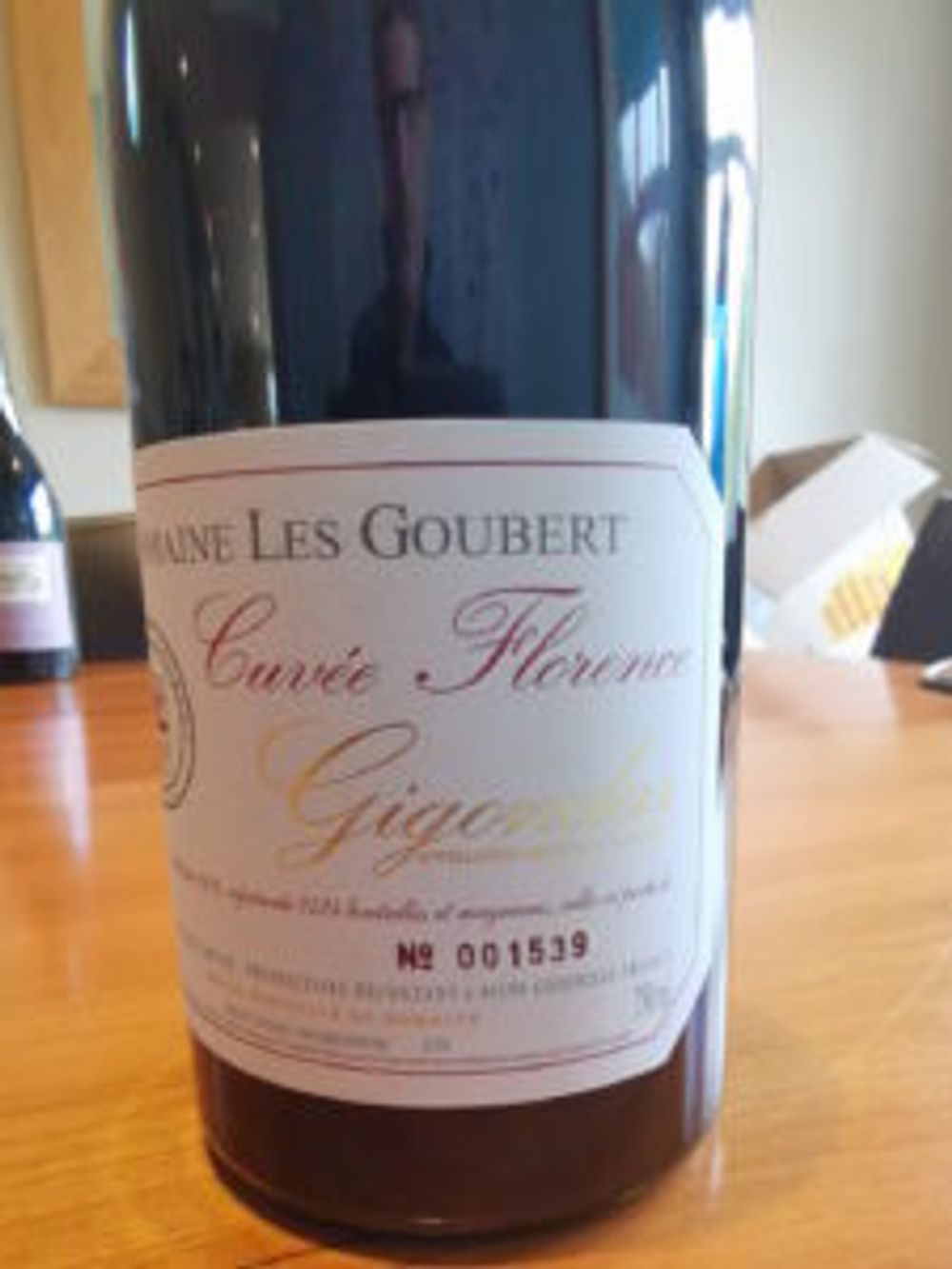
2015 Château du Trignon Gigondas: 60% Grenache, 30% Syrah, 5% Cinsault, 5% Mourvèdre. Partial destemming. Mid purple starting to brick slightly, powerful red fruit kirsch nose with gamey overtones, ripe fleshy red fruits with gamey, savoury palate; firm structure with crisp frame.
2018 Domaine des Pasquiers Gigondas. 50% Grenache, 50% Syrah. Mid purple, brambles, lovely ripe freshness, creamy red fruit coulis, garrigue and kirschy red fruits, bay, ripe tannic structure. Promising and good value.
Lead picture ©Ilka Kramer
